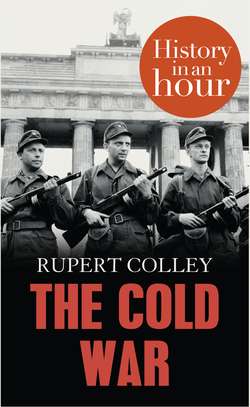Читать книгу The Cold War: History in an Hour - Rupert Colley - Страница 15
ОглавлениеKhrushchev: ‘Different roads to socialism’
However, if the East German workers thought Stalin’s death meant change, they were soon disabused, as the Stalinist leader, Walter Ulbricht, strove to increase industrial output. On 16 June 1953, workers in East Berlin went on strike. The strike soon spread to other cities and Soviet tanks had to intervene to quash the uprising. The human face of socialism only went so far.
On 25 February 1956, at the Soviet Twentieth Party Congress, Khrushchev delivered a six-hour speech to party leaders in which he denounced Stalin’s methods, acknowledged his mistakes and criticized his murderous reign. He talked also of allowing the Soviet satellites to follow ‘different roads to socialism’. The text of the speech, although secret, soon spread across Russia and abroad, causing shock that the great man’s name should be so besmirched but also relief that, through Khrushchev’s ‘de-Stalinization’, the tyranny that had overshadowed the Soviet Union for so long was now something of the past. When, eight years later in 1964, Khrushchev himself was deposed and pensioned off, he said: ‘I’m glad that the party has gotten to the point when it can rein in even its first secretary.’
In June 1956, in Poland, in a repeat of the East Berlin uprising of 1953, the workers revolted, demanding economic reform. The Polish government, in a conciliatory gesture, replaced their hardline leader with the popular and reformist Władysław Gomułka. The Poles had taken Khrushchev at his word and were following a ‘different road to socialism’. But Khrushchev was not impressed. Furious, he flew unannounced to Warsaw for a showdown with the Poles. Gomułka held his ground but promised that Poland would remain loyal to Moscow. Satisfied with this, Khrushchev withdrew.
Hungarian Revolution: revolutionaries spit on a fallen statue of Stalin, October 1956
The American Hungarian Federation
But it was the Hungarian Uprising in October 1956 that truly tested the extent of the Soviet Union’s resolve. Following the relative success in Poland, students and workers took to the streets, tearing down a huge statue of Stalin (pictured above), and demanding greater freedom and the right to worship and protesting against the excesses of the Hungarian secret police. Khrushchev ordered in Soviet troops but replaced the unpopular Hungarian leader with the reformist Imre Nagy. With Nagy in place, Khrushchev withdrew his troops to the Hungarian border.
The protest continued and hundreds of Hungary’s secret police were lynched. Nagy, siding with the rebels, demanded Hungary’s withdrawal from the Warsaw Pact and was prepared to declare Hungary’s neutrality. This went much further than Poland; Nagy had gone too far. The rebels hoped and expected support and aid from the West, but Britain and France were distracted by the emerging crisis over the Suez Canal, and the USA by presidential elections. The aid never materialized. Chairman Mao encouraged Khrushchev to take a firmer line, so Khrushchev, taking advantage of the West’s preoccupations, ordered the tanks back in. This time, with brutal efficiency, the uprising was crushed.
Nagy sought sanctuary in the Yugoslavian embassy and was replaced by the hard-line Janos Kadar, who, loyal to Moscow, remained in charge until 1988. Over 200,000 Hungarians fled across the border into Austria and the West until that escape route was sealed off. Thousands were executed by the regime in reprisal; and Nagy, lured out of the embassy, was arrested, tried and shot. Khrushchev may have denounced Stalin as a tyrant, but when need be, he could be equally as ruthless.
